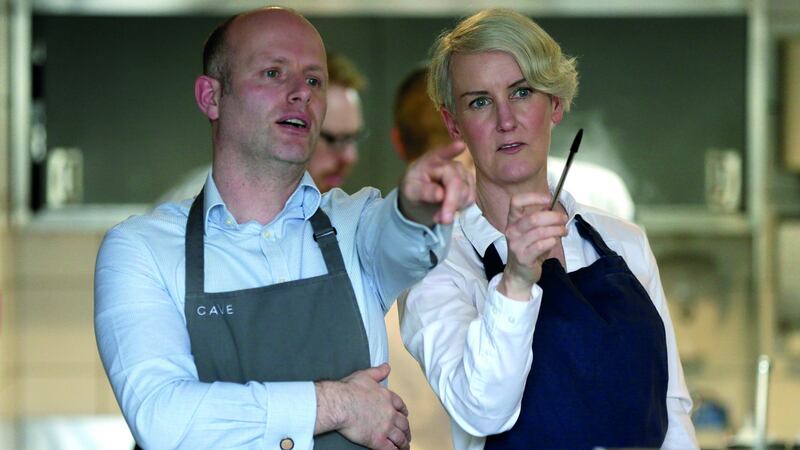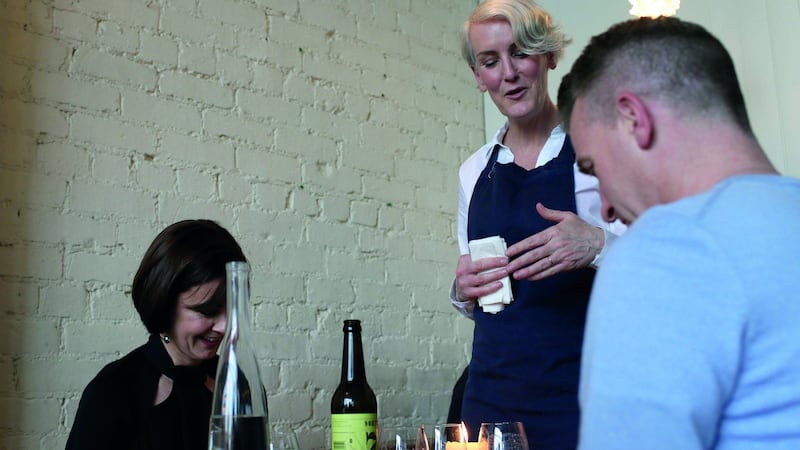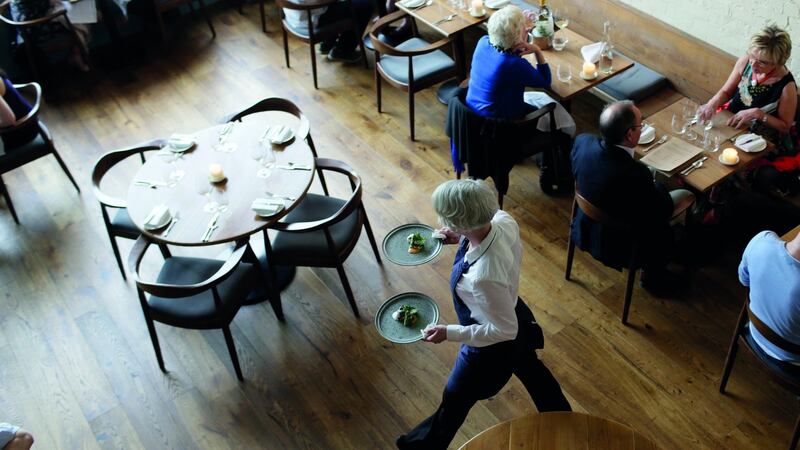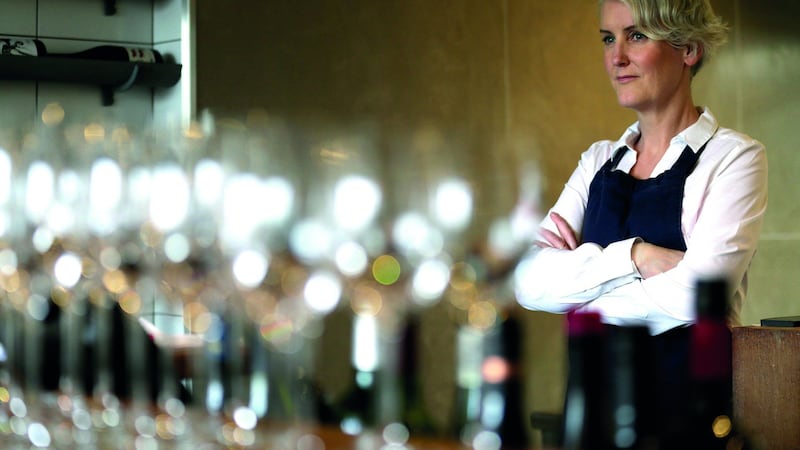All it takes is a navy apron and a white shirt from H&M and my shape shift is complete. Minutes later, a woman is handing me her scarf and heading to her seat. Later, there’ll be a double-take when she has a “no it can’t be, I think it is” conversation with her dining companion. She came to Ox in Belfast because of a review, but the critic who wrote it seems to be working here, which takes enthusiasm for a restaurant to a whole other weird level. But yes, dear diner, tonight the Irish Times restaurant critic is not sitting comfortably. I will be your server and see a restaurant’s inner workings like never before.
I’ve interviewed countless chefs. We look to the kitchen for stories about restaurants. Front-of-house folk get asked for anecdotes about diners. What’s it like dealing with narky, drunk or famous people? Is it true that Irish eaters will say it’s all “grand” and then let rip on social media? But to understand front of house is to understand restaurants. So it’s time to double knot my apron and revisit my inglorious student waitressing days.
In a Michelin-starred restaurant like Ox, the front-of-house team is as much part of the food philosophy as the chefs. And they take their tone from a man with more than three decades of service under his belt. Alain Kerloc’h went to catering college in his native Brittany when he was 14. For three summers he worked in a local Michelin-starred restaurant where he learned how much he didn’t know when he was sent to the vast wine cellar which was organised by region.

During his military service, he became maître d’ to the admiral of the Brittany navy, an admiral who travelled with his own Napoleonic cutlery. “I made sure the cutlery was right. If it’s 12 it’s 12. I don’t want to be the one to have lost a piece of Napoleon silvery cutlery.” During his first service, he felt the side of the hot silver coffee pot, assumed it was full of coffee and poured. Steaming water came from the spout. “The admiral said to me: ‘it’s a bit weak your coffee’.” The young maitre d’ survived, learned from the admiral that a boss could have something to teach you, worked in Burgundy and then Ireland, where he met his wife Laura.

“In France we learn a lot about techniques of service. In Ireland we learn a lot from the people. It’s an amazing country for hospitality . . . It’s great to mix both.”
Kerloc’h’s history with chef Stevie Toman is part of the back story that new staff get in a welcome pack. It tells how they met in Paris and opened Ox together in Belfast six years ago. The pack also name-checks the Lagan flowing outside the window and the fact that it’s 53 miles long from source to sea. And the sculpture which dominates the skyline outside? It’s the Thanksgiving Square Beacon or, its more Belfast name of Nuala with the Hula.
As far as Kerloc’h is concerned, a restaurant is not just one element. It’s everything down to the last detail. Kindness is key and an ability to listen. “If you’re approachable, if you listen to the guests, they are not going to complain to a lovely person. They complain over a slight mistake if you are a bit arrogant or not friendly. They want you to fail. But if you’re a lovely person they won’t want you to fail.”
And the commonest mistake he sees in other restaurants? “I think, and I know this is a bit vague, but it’s not listening enough to the needs of the customer, being too clinical, not adapting to every customer. That’s why I say to my new guys ‘I want you to be you’.”
How much information should I give them about what’s on their plate? “I always say ‘don’t bore my customer’. If two people are in the middle of a conversation, you’re not going to tell everything on the plate. You can see some people are really interested so you explain. Part of the skill is knowing when to leave people alone to enjoy each other’s company. And then there’s admitting when you don’t know something. “I say to the guys: ‘do not bullshit’. It’s fine to say, ‘I’ll call Alain. He’ll be able to go through something with you’.”

My chat in the comfort of a leather seat in Ox Cave with a cup of honey-sweetened tea is over. There will be no more sitting down. It’s time for the staff meal in the restaurant next door followed by the briefing. Everyone eats standing up. After five hours, my knees will feel like they’ve run a hilly 10k. But before that, there are juicy strips of beef with salad and a bowl of rhubarb crumble with custard for dessert.
“Right okay, well Catherine’s with us tonight,” Toman tells the team during the chef’s briefing. “On trial. We’ll see,” he jokes to laughter. He rattles through the tasting menu, faster than I can follow. I’ll learn these dishes by watching as they’re plated. There are 64 people booked, starting with 16 people at 6pm, 23 at 7pm, then 15 at 8pm and finally 10 at 9pm.
The pink highlighter pen has been deployed for two allergy warnings. “We’ve got two people who are both gluten and dairy,” Agnes Chmielewska tells the briefing. “There’s charcuterie next door,” the chef jokes. “No we’ll sort that out now.” There are just two vegetarian menus requested. A pink stickie on the till screen reminds everyone about a prepaid bottle of champagne on table two. Shortly into service, a regular diner will phone to ask for a last-minute table, bringing the number of people who will eat in Ox tonight to 66. At six courses, it will involve more than 400 plates of food, each expected to be perfect.
Everything feels like it’s being turned up a notch as 6pm approaches (including the thumping beat of Underworld’s Born Slippy from the Trainspotting soundtrack turned up loud just until the doors open). I’m reminded of the last thing Kerloc’h said to me about forgetting yourself when service starts. “If you have a problem outside work, the good thing about our profession is that we’re kind of like actors,” he says. “We smile. We forget about what’s happening in our life for the service. That’s great for us. It’s amazing.” So is it a show? “It’s a show. Whatever’s happening outside you forget about it because you’re busy and you’re active.”
And that’s the joy and the challenge of the next few hours. This is an active analog job, with a focus that other jobs have lost, working alongside people in constant motion. The only person who will look at a phone is Chmielewska, and then only briefly to answer a Facebook message about cancelling a booking in the wine bar. At the front desk, she welcomes people with a smile and leads them to their table. Coats are hung on a coat stand and then stowed upstairs on hooks assigned to table numbers. Numbering is a large part of how things work. Every table is numbered and every person at that table.
One of the first people to arrive is a woman who is visibly pregnant. This hasn’t been mentioned on her booking so Chmielewska quickly and quietly informs the kitchen. As a diner, you are noted and numbered at every step.

I’ve borrowed a docket book to take notes but at my next station that has to get stowed. I won’t have a free hand. I’m at the pass, a steel bench where plates have to be super-hot because there are no heat lamps. “They kill the food,” Toman says. Chefs with asbestos hands handle plates straight out from under the salamander grill. We’re using small paper napkins, folded neatly. An especially hot plate needs a double napkin, my fellow server Patricia Mycan warns me.
The pass is a tense place where the list of dockets has to be pushed through each stage. One or two mistakes and the whole thing collides train-wreck style. Servers call each dish, as the table is ready for them it’s written on the docket with the time it’s been called. (You learn to write upside down as dockets are turned towards the kitchen.) The second they’re ready, the plates are whisked to the table. Halfway there, your fingers are burning through the napkin but you’re smiling, and you have 14 steps to climb to the upstairs mezzanine to deliver the plates to table 22.
The men at table two have a question about tonight’s learner server (who also stands out because she’s roughly twice the average age of the rest of the staff). They are tickled pink to be served by a restaurant critic. “Times must be hard in journalism,” they joke. Kerloc’h’s voice in my head urging me not to “bullshit”, I realise I’m not sure about the purée which is beside the white asparagus I’ve just delivered to their table. It is, I think, an onion purée. But I will fact-check. It’s not easy asking Toman questions. He is as focused as a surgeon and tetchy when something is amiss with the thickness of a sauce or an unwiped spill. It’s a purée of white asparagus, he says. The men at table two nod and grin. They had already guessed.
One docket has “VIP” written on it. This indicates a regular who’s a friend so Toman might make his way down to say hello. I assume the docket of a critic or a Michelin inspector comes with a rainbow of marks (possibly a skull and crossbones) as it makes its way through the kitchen. A green highlighter is drawn through each dish on each docket to show it has been served.
It’s time to shadow Justine le Boulanger, the sommelier. The young French woman came here on work experience from Brittany, was talent-spotted by Kerloc’h and encouraged to go and study wine. She juggles wine pairings, individual bottles and the occasional beer order. At each table, she tells a brief story about the winemaker or the region, or the grape. She has a brilliant smile, round-rimmed glasses and is, I’m told, more likely to swear like a docker at other team members when a journalist isn’t around to hear.

My final stint is to take the dockets to the back of the kitchen where pastry chef Gráinne Mullins is making desserts.
There are exquisite bowls of rhubarb sorbet with beet crisps that have been dehydrated after being soaked in a sugar syrup. The trick to make the quenelles of sorbet? Practice, Mullins says.
I perform the less tricky job of filling in the gaps on small slices of chocolate parfait with shards of candied pecans. After touching the nuts, I have to wash my hands immediately. Every time. Allergies are a serious hazard.
After service, Mullins will hand the leftovers in to other chefs to practise getting that perfect rugby ball shape with a warmed spoon and wrist twist.
Pastry feels like a cooler, calmer place. The plates and bowls are blissfully cold. And then I’m done, sitting down to rest while the service finishes up. The team is still smiling. There’s a pride in the rigour of what they do here. Camaraderie makes up for the gruelling pace.
They have dropped the lunchtime service on a Tuesday to let everyone recover on their Sundays and Mondays off without having to prepare for a lunch service on their first day back. I can see the toll this life would take on you. It is for fit, young people who can still smile after long hours on their feet bending, carrying, wiping and clearing in a team where everyone has your back. Literally. “Backs” is the word hissed urgently as they walk towards you carrying a plate and need you to get out of the way.
It has been brilliant to drop into this organic human machine to try to find and keep its pace for a few hours. They walk swiftly and nimbly, ready to stop to avoid a collision, with all the spatial awareness and fleetness of dancers. I can see the allure as well as the challenges.
Toman offers to plate up a few dishes for me to taste but that would feel wrong. I’m on the other side of the mirror tonight. After this evening, Ox closes for a week and I slip away when the lights are still on and the candles are burning, out into the darkness with the smell of the sea wafting over quiet streets, leaving them to wind down in peace. They’ve earned it.











